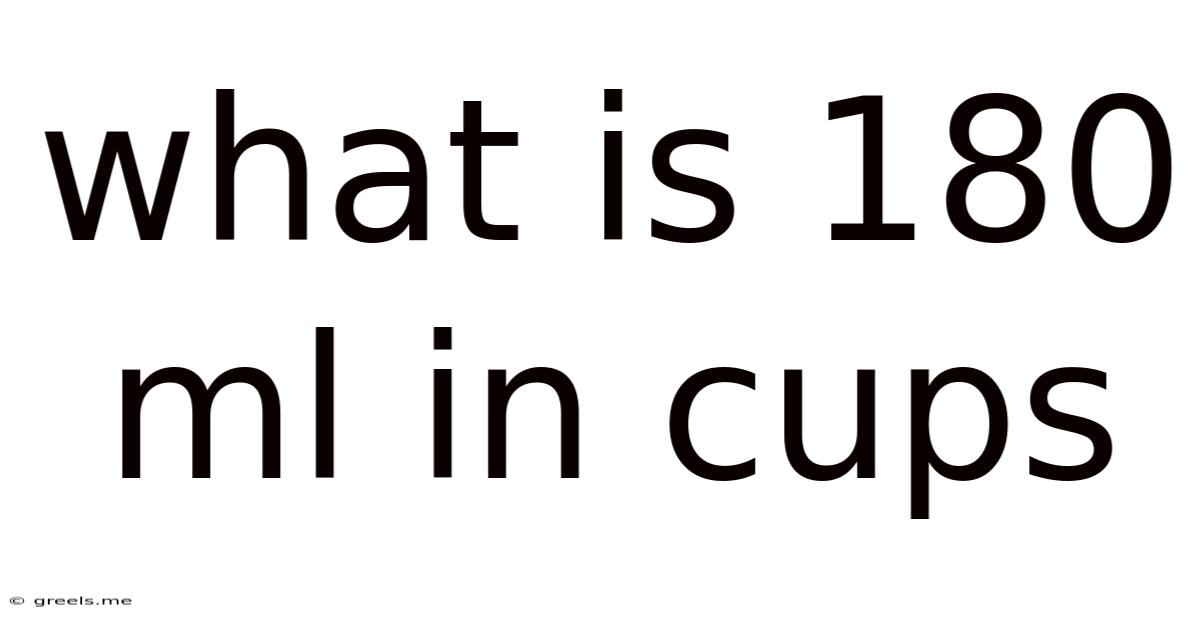What Is 180 Ml In Cups
Greels
May 23, 2025 · 4 min read

Table of Contents
What is 180 ml in Cups? A Comprehensive Guide to Metric-Imperial Conversions
Converting between metric and imperial units can be confusing, especially when dealing with cooking and baking measurements. One common question is: what is 180 ml in cups? This comprehensive guide will not only answer that question but also equip you with the knowledge and tools to confidently convert between milliliters (ml) and cups (c) in any situation.
Understanding the Units: Milliliters and Cups
Before diving into the conversion, let's clarify the units involved.
-
Milliliters (ml): A milliliter is a unit of volume in the metric system. It's a small unit, often used for measuring liquids like water, milk, or oil.
-
Cups (c): A cup is a unit of volume in the imperial system. The size of a cup can vary slightly depending on the region and even the type of cup used (e.g., a measuring cup vs. a teacup). For the sake of consistency and accuracy in conversions, we'll use the standard US customary cup, which is equivalent to 236.59 milliliters.
Calculating 180 ml in Cups
The direct conversion from milliliters to cups is straightforward:
180 ml / 236.59 ml/cup ≈ 0.76 cups
Therefore, 180 ml is approximately three-quarters of a cup (¾ cup).
Beyond the Basic Conversion: Factors Affecting Accuracy
While the above calculation provides a good estimate, several factors can influence the precision of the conversion:
1. Variations in Cup Sizes
As mentioned earlier, cup sizes aren't universally standardized. While the US customary cup is the most common reference point for conversions, other regions may use slightly different cup sizes. This variation can lead to minor discrepancies in the final measurement. Always be mindful of the specific cup size being used in a recipe or context.
2. Liquid vs. Dry Ingredients
The conversion between ml and cups can be slightly different depending on whether you're measuring liquids or dry ingredients. Liquids tend to settle differently than dry ingredients like flour or sugar. Packing and scooping techniques can also impact volume. For instance, tightly packed flour will occupy a smaller volume than lightly scooped flour, even if both are measured using the same cup.
3. Temperature and Density
The density of a liquid can change depending on its temperature. Cold liquids are generally denser than warm liquids. This minor difference in density can impact the volume, though the effect is usually negligible for most everyday conversions.
Practical Applications and Examples
Let's explore how the 180 ml to cup conversion applies in various scenarios:
Cooking and Baking:
Many recipes, particularly those from different regions, may use either milliliters or cups for liquid ingredients. Knowing how to convert between them is essential for accurate recipe execution. For instance, if a recipe calls for 180 ml of milk and you only have measuring cups, you can confidently substitute with roughly ¾ of a cup.
Example: A recipe calls for 180 ml of water, and you have a standard measuring cup. Use approximately ¾ of a cup.
Scientific Experiments and Measurements:
In scientific settings, precise measurements are critical. While ml is the preferred unit in scientific experiments, it’s essential to be able to convert into different systems if the apparatus or instrument necessitates.
Everyday Use:
Even outside of cooking and science, understanding these conversions can be helpful. For example, if you need to measure medication or determine the amount of liquid in a bottle.
Example: A small bottle of medication contains 180 ml. It’s helpful to know this equates to approximately ¾ cup for context.
Advanced Techniques and Tools for Conversion
While a simple division can suffice for many conversions, more advanced techniques can improve accuracy.
Using Online Conversion Tools:
Several websites and apps provide precise milliliter-to-cup converters. These tools often account for variations in cup sizes and provide more accurate results than simple manual calculations.
Employing Conversion Tables:
Creating or using a conversion table can speed up the process of converting between milliliters and cups, particularly if you frequently work with these units. The table should include common milliliter volumes and their corresponding cup equivalents.
Troubleshooting Common Conversion Issues
Here are some tips to resolve potential issues when converting 180 ml to cups:
-
Double-check your measuring tools: Ensure that your measuring cups are accurate and properly calibrated.
-
Consider the ingredient type: Remember that the conversion can vary slightly depending on whether you are measuring liquids or dry ingredients.
-
Use online converters for precision: For critical applications, use an online converter to ensure accuracy.
Conclusion: Mastering Milliliter to Cup Conversions
Understanding how to convert 180 ml to cups, and more generally, how to convert between milliliters and cups, is a valuable skill. Whether you’re following a recipe, conducting an experiment, or simply trying to understand a measurement, mastering these conversions ensures precision and accuracy. By accounting for potential variations and utilizing tools like online converters and conversion tables, you can confidently navigate the metric and imperial systems and succeed in your endeavors. This comprehensive guide equips you with the knowledge and resources to confidently tackle any milliliter-to-cup conversion you might encounter. Remember to always double-check your measurements and choose the most suitable method based on the specific context of your task. Happy converting!
Latest Posts
Related Post
Thank you for visiting our website which covers about What Is 180 Ml In Cups . We hope the information provided has been useful to you. Feel free to contact us if you have any questions or need further assistance. See you next time and don't miss to bookmark.